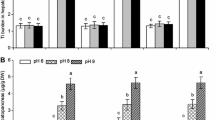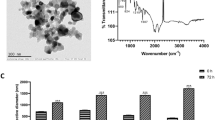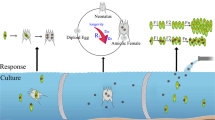Abstract
The widespread use of nanoparticles (NPs) and organic pollutants increases the risk of their coexistence in the aquatic environments. It is uncertain how the combined toxicities of NPs and OCs affect aquatic organisms in surface waters. In this study, the binary combined toxicities of TiO2 NPs with three different organochlorines (OCs)-pentachlorobenzene (PeCB), 3,3,4,4-tetrachlorobiphenyl (PCB-77), and atrazine on Chlorella pyrenoidosa in three karst surface water bodies were investigated. The correlation analysis results indicated that the toxicities of TiO2 NPs and OCs to algae were mainly related to the total organic carbon (TOC) and ionic strength of surface water. Surface water relieved the growth inhibition of the pollutants on algae as compared with ultrapure water (UW). The combined toxic effect caused by the co-exposure of TiO2 NPs-atrazine was synergistic and had an antagonistic effect for TiO2 NPs-PCB-77 in four types of water bodies. However, the co-exposure of TiO2 NPs-PeCB had an additive effect in the Huaxi Reservoir (HX) and synergistic effects in Baihua Lake (BH), Hongfeng Lake (HF), and UW. TiO2 NPs increased the bioaccumulation of OCs by algae. Both PeCB and atrazine significantly increased the bioaccumulation of TiO2 NPs by algae, except for PeCB in HX; however, PCB-77 reduced the bioaccumulation of TiO2 NPs by algae. The toxic effects of TiO2 NPs and OCs on algae in different water bodies were the result of the nature of the pollutants, bioaccumulation, hydrochemical properties, and other factors.
Graphical abstract







Similar content being viewed by others
Data availability
All data generated or analyzed during this study are included in this published article.
References
Aiken GR, Hsu-Kim H, Ryan JN (2011) Influence of dissolved organic matter on the environmental fate of metals, nanoparticles, and colloids. Environ Sci Technol 45(8):3196–3201. https://doi.org/10.1021/es103992s
Belden JB, Gilliom RJ, Lydy MJ (2007) How well can we predict the toxicity of pesticide mixtures to aquatic life? Integr Environ Assess Manage 3(3):364–372. https://doi.org/10.1002/ieam.5630030307
Cabrera-Rodríguez R, Luzardo OP, Almeida-González M, Boada LD, Zumbado M, Henríquez-Hernández LA (2020) Database of persistent organic pollutants in umbilical cord blood: concentration of organochlorine pesticides, PCBs, BDEs and polycyclic aromatic hydrocarbons. Data Brief 28:104918. https://doi.org/10.1016/j.dib.2019.104918
Chen KL, Elimelech M (2007) Influence of humic acid on the aggregation kinetics of fullerene (C60) nanoparticles in monovalent and divalent electrolyte solutions. J Colloid Interface Sci 309(1):126–134. https://doi.org/10.1016/j.jcis.2007.01.074
Clément L, Hurel C, Marmier N (2013) Toxicity of TiO2 nanoparticles to cladocerans, algae, rotifers and plants–effects of size and crystalline structure. Chemosphere 90(3):1083–1090. https://doi.org/10.1016/j.chemosphere.2012.09.013
Dalai S, Pakrashi S, Nirmala MJ, Chaudhri A, Chandrasekaran N, Mandal AB, Mukherjee A (2013) Cytotoxicity of TiO2 nanoparticles and their detoxification in a freshwater system. Aquat Toxicol 138:1–11. https://doi.org/10.1016/j.aquatox.2013.04.005
Dale AL, Casman EA, Lowry GV, Lead JR, Viparelli E, Baalousha M (2015) Modeling nanomaterial environmental fate in aquatic systems. Environ Sci Technol 49(5):2587–2593. https://doi.org/10.1021/es505076w
Domingos RF, Tufenkji N, Wilkinson KJ (2009) Aggregation of titanium dioxide nanoparticles: role of a fulvic acid. Environ Sci Technol 43(5):1282–1286. https://doi.org/10.1021/es8023594
Du YJ, Xu X, Liu QZ, Bai L, Hang KX, Wang DH (2022) Identification of organic pollutants with potential ecological and health risks in aquatic environments: progress and challenges. Aquat Toxicol 806:150691. https://doi.org/10.1016/j.scitotenv.2021.150691
Dubsok A, Khamdahsag P, Kittipongvises S (2022) Life cycle environmental impact assessment of cyanate removal in mine tailings wastewater by nano-TiO2/FeCl3 photocatalysis. J Cleaner Prod 366:132928. https://doi.org/10.1016/j.jclepro.2022.132928
Freixa A, Acuña V, Sanchís J, Farré M, Barceló D, Sabater S (2018) Ecotoxicological effects of carbon based nanomaterials in aquatic organisms. Sci Total Environ 619:328–337. https://doi.org/10.1016/j.scitotenv.2017.11.095
Gao X, Deng R, Lin DH (2020) Insights into the regulation mechanisms of algal extracellular polymeric substances secretion upon the exposures to anatase and rutile TiO2 nanoparticles. Environ Pollut 263:114608. https://doi.org/10.1016/j.envpol.2020.114608
Garg S, Wang L, Schenk PM (2014) Effective harvesting of low surface-hydrophobicity microalgae by froth flotation. Bioresour Technol 159:437–441. https://doi.org/10.1016/j.biortech.2014.03.030
Gelfand P, Smith RJ, Stavitski E, Borchelt DR, Miller LM (2015) Characterization of protein structural changes in living cells using time-lapsed FTIR imaging. Anal Chem 87(12):6025–6031. https://doi.org/10.1021/acs.analchem.5b00371
Gottschalk F, Sonderer T, Scholz RW, Nowack B (2009) Modeled environmental concentrations of engineered nanomaterials (TiO2, ZnO, Ag, CNT, fullerenes) for different regions. Environ Sci Technol 43(24):9216–9222. https://doi.org/10.1021/es9015553
Gu X, Ma T, Wu Y, Wu X (2017) Hydrogeochemical characteristics of groundwater in the Karst region, southwest China. Procedia Earth Planet Sci 17:245–248. https://doi.org/10.1016/j.proeps.2016.12.045
Gunawan C, Teoh WY, Marquis CP, Amal R (2011) Cytotoxic origin of copper (II) oxide nanoparticles: comparative studies with micron-sized particles, leachate, and metal salts. ACS Nano 5(9):7214–7225. https://doi.org/10.1021/nn2020248
Huang XZ, Liu ZK, Xie Z, Dupont S, Huang W, Wu FL, Kong H, Liu LP, Sui YM, Lin DH, Lu WQ, Hu MH, WangYJ, (2018) Oxidative stress induced by titanium dioxide nanoparticles increases under seawater acidification in the thick shell mussel Mytilus coruscus. Mar Environ Res 137:49–59. https://doi.org/10.1016/j.marenvres.2018.02.029
Ji ZX, Jin X, George S, Xia T, Meng H, Wang X, Suarez E, Zhang HY, Hoek EMV, Godwin H, Nel AE, Zink JI (2010) Dispersion and stability optimization of TiO2 nanoparticles in cell culture media. Environ Sci Technol 44(19):7309–7314. https://doi.org/10.1021/es100417s
Ji J, Long ZF, Lin DH (2011) Toxicity of oxide nanoparticles to the green algae Chlorella sp. Chem Eng J 170(2–3):525–530. https://doi.org/10.1016/j.cej.2010.11.026
Keller AA, Lazareva A (2014) Predicted releases of engineered nanomaterials: from global to regional to local. Environ Sci Technol Lett 1(1):65–70. https://doi.org/10.1021/ez400106t
Keller AA, Wang HT, Zhou DX, Lenihan HS, Cherr G, Cardinale BJ, Miller R, Ji ZX (2010) Stability and aggregation of metal oxide nanoparticles in natural aqueous matrices. Environ Sci Technol 44(6):1962–1967. https://doi.org/10.1021/es902987d
Koelmans AA (2014) Limited reversibility of bioconcentration of hydrophobic organic chemicals in phytoplankton. Environ Sci Technol 48(13):7341–7348. https://doi.org/10.1021/ez400106t
Kunhikrishnan A, Shon HK, Bolan NS, El Saliby I, Vigneswaran S (2015) Sources, distribution, environmental fate, and ecological effects of nanomaterials in wastewater streams. Crit Rev Environ Sci Technol 45(4):277–318. https://doi.org/10.1080/10643389.2013.852407
Li M, Luo Z, Yan Y, Wang Z, Chi Q, Yan C, Xing B (2016) Arsenate accumulation, distribution, and toxicity associated with titanium dioxide nanoparticles in Daphnia magna. Environ Sci Technol 50(17):9636–9643. https://doi.org/10.1021/acs.est.6b01215
Lin DH, Ji J, Long ZF, Yang K, Wu FC (2012) The influence of dissolved and surface-bound humic acid on the toxicity of TiO2 nanoparticles to Chlorella sp. Water Res 46(14):4477–4487. https://doi.org/10.1016/j.watres.2012.05.035
Long ZF, Ji J, Yang K, Lin DH, Wu FC (2012) Systematic and quantitative investigation of the mechanism of carbon nanotubes’ toxicity toward algae. Environ Sci Technol 46(15):8458–8466. https://doi.org/10.1021/es301802g
Loosli F, Le Coustumer PL, Stoll S (2013) TiO2 nanoparticles aggregation and disaggregation in presence of alginate and Suwannee River humic acids. pH and concentration effects on nanoparticle stability. Water Res 47(16):6052–6063. https://doi.org/10.1016/j.watres.2013.07.021
Lu WF, Alam MA, Pan Y, Wu JC, Wang ZM, Yuan ZH (2016) A new approach of microalgal biomass pretreatment using deep eutectic solvents for enhanced lipid recovery for biodiesel production. Bioresour Technol 218:123–128. https://doi.org/10.1016/j.biortech.2016.05.120
Ma S, Lin DH (2013) The biophysicochemical interactions at the interfaces between nanoparticles and aquatic organisms: adsorption and internalization. Environ Sci: Processes Impacts 15(1):145–160. https://doi.org/10.1039/C2EM30637A
Natarajan L, Jenifer MA, Chandrasekaran N, Suraishkumar GK, Mukherjee A (2022) Polystyrene nanoplastics diminish the toxic effects of Nano-TiO2 in marine algae Chlorella sp. Environ Res 204:112400. https://doi.org/10.1016/j.envres.2021.112400
Rezende TC, Silvestre JCM, Mendonça PV, Moniz J, Serra AC, Coelho JFJ (2022) Efficient dispersion of TiO2 in water-based paint formulation using well-defined poly [oligo (ethylene oxide) methyl ether acrylate] synthesized by ICAR ATRP. Prog Org Coat 165:106734. https://doi.org/10.1016/j.porgcoat.2022.106734
Robichaud CO, Uyar AE, Darby MR, Zucker LG, Wiesner MR (2009) Estimates of upper bounds and trends in nano-TiO2 production as a basis for exposure assessment. Policy Anal 43(12):4227–4233. https://doi.org/10.1021/es8032549
Romanello MB, de Cortalezzi MMF (2013) An experimental study on the aggregation of TiO2 nanoparticles under environmentally relevant conditions. Water Res 47(12):3887–3898. https://doi.org/10.1016/j.watres.2012.11.061
Sendra M, Moreno-Garrido I, Yeste MP, Gatica JM, Blasco J (2017) Toxicity of TiO2, in nanoparticle or bulk form to freshwater and marine microalgae under visible light and UV-A radiation. Environ Pollut 227:39–48. https://doi.org/10.1016/j.envpol.2017.04.053
Simonin M, Richaume A, Guyonnet JP, Dubost A, Martins JM, Pommier T (2016) Titanium dioxide nanoparticles strongly impact soil microbial function by affecting archaeal nitrifiers. Sci Rep 6(1):33643. https://doi.org/10.1038/srep33643
Singh S, Shi T, Duffin R, Albrecht C, van Berlo D, Höhr D, Fubini B, Martra G, Fenoglio I, Borm PJA, Schins RPF (2007) Endocytosis, oxidative stress and IL-8 expression in human lung epithelial cells upon treatment with fine and ultrafine TiO2: role of the specific surface area and of surface methylation of the particles. Toxicol Appl Pharmacol 222(2):141–151. https://doi.org/10.1016/j.taap.2007.05.001
Wang ZY, Yin LY, Zhao J, Xing BS (2016) Trophic transfer and accumulation of TiO2 nanoparticles from clamworm (Perinereis aibuhitensis) to juvenile turbot (Scophthalmus maximus) along a marine benthic food chain. Water Res 95:250–259. https://doi.org/10.1016/j.watres.2016.03.027
Weschenfelder SE, Louvisse AMT, Borges CP, Meabe E, Izquierdo J, Campos JC (2015) Evaluation of ceramic membranes for oilfield produced water treatment aiming reinjection in offshore units. Geoenergy Sci Eng 131:51–57. https://doi.org/10.1016/j.petrol.2015.04.019
Wu HH, Yin JJ, Wamer WG, Zeng MY, Lo YM (2014) Reactive oxygen species-related activities of nano-iron metal and nano-iron oxides. J Food Drug Anal 22(1):86–94. https://doi.org/10.1016/j.jfda.2014.01.007
Yu C, Irudayaraj J (2005) Spectroscopic characterization of microorganisms by Fourier transform infrared microspectroscopy. Biopolymers 77(6):368–377. https://doi.org/10.1002/bip.20247
Zaynab M, Fatima M, Sharif Y, Sughra K, Sajid M, Khan KA, Sneharani AH, Li SF (2021) Health and environmental effects of silent killers organochlorine pesticides and polychlorinated biphenyl. J King Saud Univ Sci 33(6):101511. https://doi.org/10.1016/j.jksus.2021.101511
Zhang LQ, Lei C, Chen JJ, Yang K, Zhu LZ, Lin DH (2015) Effect of natural and synthetic surface coatings on the toxicity of multiwalled carbon nanotubes toward green algae. Carbon 83:198–207. https://doi.org/10.1016/j.carbon.2014.11.050
Zhang LQ, Li J, Yang K, Liu JF, Lin DH (2016) Physicochemical transformation and algal toxicity of engineered nanoparticles in surface water samples. Environ Pollut 211:132–140. https://doi.org/10.1016/j.envpol.2015.12.041
Zhang S, Lin DH, Wu FC (2016) The effect of natural organic matter on bioaccumulation and toxicity of chlorobenzenes to green algae. J Hazard Mater 311:186–193. https://doi.org/10.1016/j.jhazmat.2016.03.017
Zhang S, Deng R, Lin DH, Wu FC (2017) Distinct toxic interactions of TiO2 nanoparticles with four coexisting organochlorine contaminants on algae. Nanotoxicology 11(9–10):1115–1126. https://doi.org/10.1080/17435390.2017.1398358
Zhang J, Xie XJ, Li Q, Wang J, Zhang S (2023) Combined toxic effects of TiO2 nanoparticles and organochlorines on Chlorella pyrenoidosa in karst area natural waters. Aquat Toxicol 257:106442. https://doi.org/10.1016/j.aquatox.2023.106442
Acknowledgements
This work was supported by the National Natural Science Foundation of China (41807336), the Guizhou Provincial Science and Technology Foundation ([2020]1Y189; LH[2017]7345; [2018]5769-19), and the Guizhou Provincial Construction Foundation of World Class Universities: Subject Group of Karst Ecological Environment ([2019]125).
Author information
Authors and Affiliations
Contributions
Jun Zhang: data curation, conceptualization, and writing of the original draft. Xujiao Xie: validation and methodology. Qing Li: validation. Ji Wang: data curation. Shuai Zhang: writing, review, editing, and funding acquisition.
Corresponding author
Ethics declarations
Ethical approval
Not applicable.
Consent to participate
Not applicable.
Consent for publication
Not applicable.
Competing interests
The authors declare no competing interests.
Additional information
Responsible Editor: Wei Liu
Publisher's note
Springer Nature remains neutral with regard to jurisdictional claims in published maps and institutional affiliations.
Supplementary information
Below is the link to the electronic supplementary material.
Rights and permissions
Springer Nature or its licensor (e.g. a society or other partner) holds exclusive rights to this article under a publishing agreement with the author(s) or other rightsholder(s); author self-archiving of the accepted manuscript version of this article is solely governed by the terms of such publishing agreement and applicable law.
About this article
Cite this article
Zhang, J., Xie, X., Li, Q. et al. Assessment of combined algal toxicity of TiO2 nanoparticles and organochlorines in karst surface waters. Environ Sci Pollut Res 30, 66625–66637 (2023). https://doi.org/10.1007/s11356-023-27139-2
Received:
Accepted:
Published:
Issue Date:
DOI: https://doi.org/10.1007/s11356-023-27139-2




